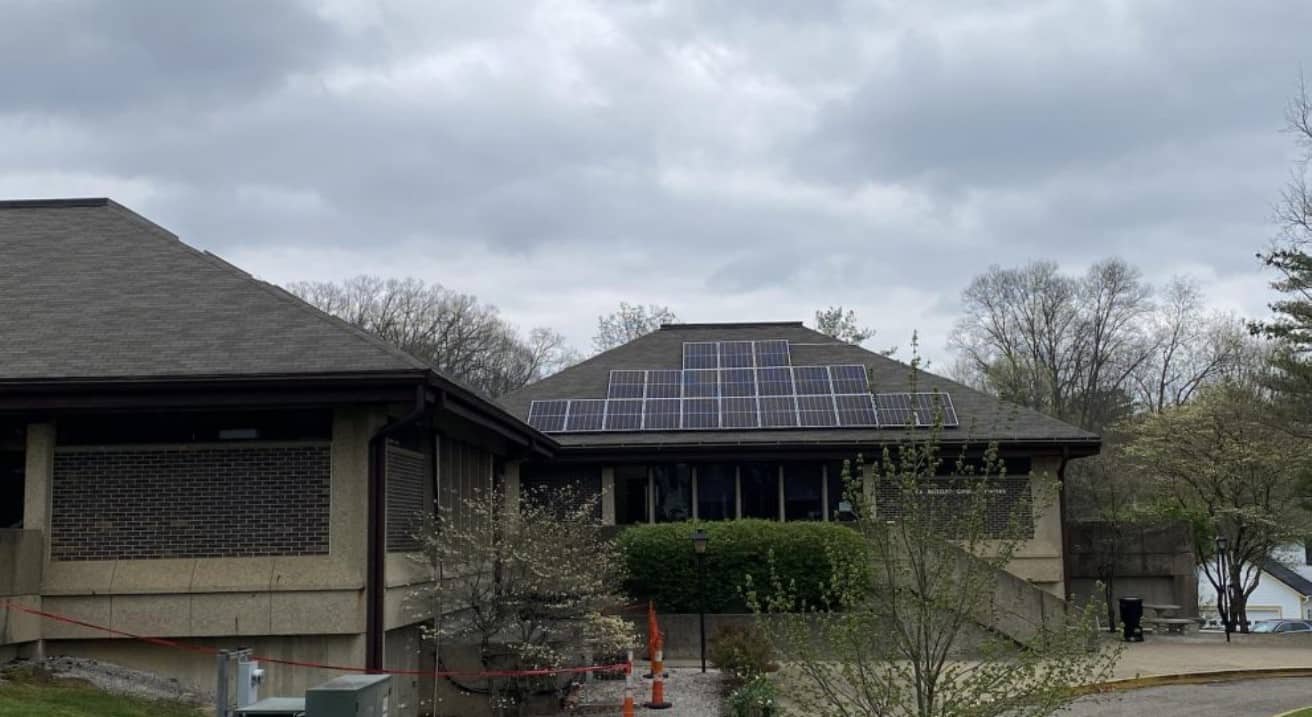On April 18, construction crews began installing solar panels on the roof of Gund Commons. The project — which is slated to be completed by May 6 — will more than double Kenyon’s generation of on-campus renewable energy.
In 2015, Kenyon committed to reaching carbon neutrality by 2040. This commitment to sustainability was echoed in the College’s most recent strategic plan, and in a sustainability statement adopted this past fall. In that statement, the Office of Communications announced that Kenyon had purchased renewable energy credits to cover much of its energy consumption. In order to achieve its goal of carbon neutrality by 2040, Kenyon has contracted Ever-Green Energy — the same company contracted by Oberlin College — to develop a decarbonization master plan for the College.
The project is connected to the Solar Power Systems (ENVS 104) class, which is offered every year. Assistant Professor of Physics Eric Holdener, who teaches the course, explained that the project was developed by Third Sun Solar. “The Solar Power course [in spring 2020] adopted the Gund Commons system as the working project for our students’ final project in the course,” Holdener wrote in a message to the Collegian. “The intention was that we would compare the student groups’ designs to that which Third Sun had developed.”
President Sean Decatur expressed excitement about the solar power project, specifically regarding the opportunity for student involvement in its installation. “Gund Commons will be the largest [project] that that class has taken on,” he said. “It’s really exciting to see that move forward.”
According to Director of Green Initiatives Dave Heithaus, the Gund solar project was initially slated for spring of 2020, before it was interrupted by the start of the COVID-19 pandemic. Heithaus explained that the College had not approved the labor costs to install the panels until now, as the budget of the project was cut due to the pandemic. “We had to wait a couple of budget cycles before we could sneak it back in,” he said.
Heithaus also noted that the solar panels currently being installed at Gund Commons are associated with the West Quad’s Leadership in Energy and Environmental Design (LEED) certification, which awards certifications for sustainable construction projects. Chalmers Library received a LEED platinum rating, the highest available. “We were able to combine it with the other renewable [energy] generation on campus to hit the threshold for those LEED points,” he said.
Heithaus added that Gund Commons was selected as the site of the project, rather than one of the new West Quad buildings, both for aesthetic reasons and because the Gund Commons roof is better positioned to receive sunlight.
Throughout the construction, Gund Commons has remained open, though the installation has closed off different entrances to the building at various times to ensure pedestrian safety.
The Gund solar project constitutes a 60-kilowatt system, which, according to Heithaus, brings campus renewable energy generation to 100 kilowatts. This number includes smaller solar-power systems at the Kenyon Farm, the Village Inn, Hoehn-Saric House and the Village Market. According to Heithaus, Kenyon’s energy demand is around 19 to 20 million kilowatts.
While the project is Kenyon’s largest ever solar energy project, Heithaus emphasized that Kenyon still has a long way to go when it comes to on-campus renewable energy. “They are moving us in the right direction — at not the fastest pace, but a pace which is better than no pace — and providing some really valuable experience for the students who go through those classes,” he said.
The College will determine its next steps towards carbon neutrality based on a report generated by Ever-Green Energy. Heithaus further explained the timeline of this process. “They’re taking a year, from April to April, to really understand our campus and give us a series of technical solutions and financial mechanisms to implement them, that would take us to net-neutral emissions by 2040,” he said.
In April of 2023, Ever-Green Energy will have completed its report, and the Board of Trustees will evaluate it and decide on concrete steps forward. However, Decatur said that more information on potential sustainability projects will be available in the fall, though it was unclear when these projects would be announced.

